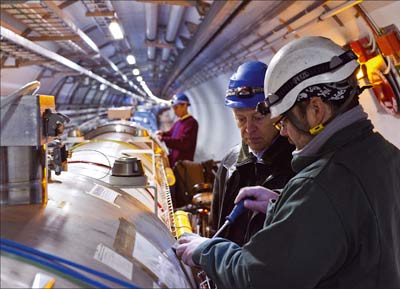CERN Prepares for Long 7 TeV Run
The Chamonix workshop, held on 25–29 January, once again proved its worth as a place where all of the stakeholders in the LHC can come together, take difficult decisions and reach a consensus on
 |
| Work on the new quench-protection system comes to an end |
Before the 2009 running period began, all of the necessary preparations to run the LHC at the collision energy of 1.18 TeV per beam had been carried out. The goal of the technical stop, scheduled to end in mid-February, was to prepare the machine for running at 3.5 TeV per beam, which requires a current of 6 kA in the LHC magnets.
The main work during the stop was on the new quench-protection system (nQPS), which is designed to improve the electrical reliability of the connection between the instrumentation feedthrough systems on the magnets and the nQPS equipment. There are around 500 of these connectors for each of the eight sectors in the LHC. An intensive effort ensured that this work was undertaken and completed in the first three weeks of January, so that the hardware-commissioning teams could proceed with testing the magnets up to 6 kA.
Several other teams took advantage of the stop to carry out other technical verifications and efficiency tests, for example, on some vacuum pumping units, the kicker system, the oxygen-deficiency hazard detectors, and on some ventilation components. At the same time as this work on the LHC, repairs took place on the water-cooling system of the CMS experiment.
All work, both in the LHC and in the CMS experiment, was scheduled to be completed by mid-February. The machine operations team will then begin to re-commission the LHC at 450 GeV per beam, building on the experience gained after the restart last year and completing investigations of machine parameters at this energy (CERN Courier January/February 2010 p24). The team will then prepare for the first ramps to 3.5 TeV per beam. Collisions at 3.5 TeV will follow, but only after the operators have established the appropriate running conditions.
Source: CERN Courier Website